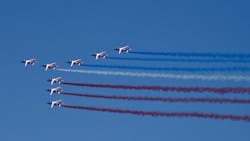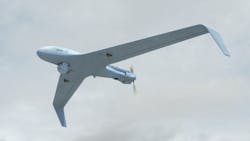A look back at the biggest aerospace stories of 2019
Intelligent Aerospace commentary
It was a year of technological achievements and blockbuster deals in the aerospace world, but 2019 was overshadowed by the grounding of Boeing's best-selling 737 Max line of commercial jets following a pair of deadly crashes in late 2018 and early 2019.
The crashes were linked to the jet's Maneuvering Characteristics Augmentation System (MCAS) which is used to enhance pitch stability of the aircraft, but it is thought the system in both crashes pointed the nose of the jet shaprly downward.
In October, then-Boeing president and CEO Dennis Muilenburg testified before the U.S. Senate Committee on Commerce, Science and Transportation regarding aviation safety and the 737 MAX airplane after a pair of deadly crashes were tied to the company's MCAS system.
“On behalf of myself and the Boeing company, we are sorry, we are deeply and truly sorry,” Muilenburg said at the time, “We’ve made mistakes and we got some things wrong.”
In late December, Boeing replaced Muilenburg and announced that Boeing Chief Financial Officer Greg Smith will serve as interim CEO during the brief transition period. David L. Calhoun will be named as Chief Executive Officer and President effective January 13, 2020.
The Boeing Company held off shutting down 737 Max aircraft production for nearly all of 2019, but eventually decided to halt production in mid-December, with the stoppage actually beginning this month, which will impact suppliers.
Boeing's suppliers, from giants like GE to lesser-known firms who make smaller components, much is up in the air. In all, some 600 companies contribute parts to the Max. Boeing said that it would halt production of its best-selling jet in January, 2020. In the spring of 2019, Boeing slowed production of its Max and caused some suppliers to adjust its workforce plans. With a stoppage of production, experts cited in a New York Times piece note it could have a devastating impact for manufacturers of parts if it lasts more than a month.
It wasn't all bad news for Boeing, however, as the Chicago-based company made a splash at the 2019 Paris Air Show.
What may be considered the biggest surprise of the show may have happened when Boeing announced that the International Airlines Group (IAG) would be purchasing 200 of their MAX jets. The two companies said they have been in discussions regarding the possible purchase, and signed a letter of intent at Paris. Speculators note that IAG likely saw a sizable discount on the list price of the aircraft, but the purchase may instill confidence in other carriers possibly following suit. At Paris, European rival Airbus noted it intended to challenge the deal with IAG.
On the first day at Le Bourget, Airbus Airbus made a splash when it formally unveiled its 321XLR (for “xtra long range”) single-aisle commercial aircraft that will travel 4,000 nautical miles while burning 30% less fuel than last-gen aircraft from competitors, according to Airbus. The aircraft, which measures 146 feet long, with a cabin measuring 113 feet, will hold between 180 and 220 passengers in a typical two-class configuration.
Lebanese carrier Middle East Air became the first 321XLR customer when it inked a deal with Airbus at Le Bourget for four of the new aircraft, while additional orders came in from American Airlines, Indigo, Cebu Pacific Airlines, Qantas Airways and British Airways parent company, IAG.
Talking tech
On the technology front, there was a lot of emphasis on “green” flight at Paris. The Pipistrel ALPHA ELECTRO 167 took to the skies powered by its 60kW electric engine. With mega-companies like Boeing and Airbus investing in electric technology for their autonomous “flying taxis” and manufacturers like GE developing commercial engines that employ electric motors, it seems evident that hybrid-electric flight could soon become the new norm in aircraft manufacturing.
Both Boeing and Airbus brought their “flying taxis” to Le Bourget, and Israeli startup Eviation brought its nine passenger, all electric “middle mile” plane, which it named “Alice.” Eviation has put its electric flyer on pre-sale and the company will complete its first flights and begin manufacturing in the U.S. in 2019, and, in conjunction with commercial customers and the FAA, will bring certified fleets to market in 2022. Alice will be targeting "middle mile" commutes around the world for routes like France's Paris to Toulouse, Norway's Oslo to Trondheim, and America's San Jose to San Diego.
Military matters
There were also interesting displays and demonstrations on the military side of things at the expo as French manufacturer Dassault had on display a rough look at what the Future Combat Air System (FCAS) jet will look like when it takes to the skies for the first time in 2026. The fighter is being developed by Dassault alongside Airbus, and will be put into service by Spain and Germany in addition to France.
Hermes 45 offers a unique combination of extended range and duration with point launch and recovery, to and from land and maritime platforms thus enhancing Intelligence, Surveillance, Target Acquisition and Reconnaissance (ISTAR) capabilities at the brigade and division levels and also for naval squadron units.
This winter, the United States Congress approved the next National Defense Authorization Act (NDAA) which gives U.S. President Donald Trump his coveted "space force." The $738 billion defense bill provides an increase of approximately 2.8% in defense spending, including nearly $660 billion for the Department of Defense and Department of Energy's security programs, $71.5 billion to pay for ongoing wars, and about $5.3 billion to pay for repairs following natural disasters. The NDAA bars further transfers of Lockheed Martin's F-35s to Turkey after the NATO ally purchased a Russian-made missile defense system.
The "space force" news came months after India successfully intercepted and destroyed a satellite in low-earth orbit. Indian Prime Minister Narendra Modi claimed that the satellite was destroyed during an announcement March 27.
India joined just the United States, China, and Russia in successfully shooting down a satellite. The U.S. and the former USSR both intercepted satellites. Most recently, in 2007, China performed the feat, much to the displeasure of the United States, who said the test was irresponsible and spread debris that may endanger the International Space Station and other satellites.
Please see the January 7, 2020 Intelligent Aerospace weekly newsletter to see more of 2019's top stories. Please click here to sign up for our newsletter if you haven't already done so.
About the Author
Jamie Whitney
Senior Editor
Jamie Whitney joined the staff of Military & Aerospace Electronics in 2018 and oversees editorial content and produces news and features for Military & Aerospace Electronics, attends industry events, produces Webcasts, and oversees print production of Military & Aerospace Electronics.

